Topics
Category
Era
Kline Sanatorium
Color postcard depicting the Kline Sanatorium, with the staff and Kline family gathered out front. Undated; photographer unknown. Anoka County Historical Society, object ID #2057.6.13. Used with the permission of the Anoka County Historical Society.
The Kline Sanatorium was built in 1902 by Dr. James Kline and served hundreds of patients before it closed in 1935. Serving as a shelter for those left without homes in the wake of a 1939 tornado, the building again provided relief for people in the area. Later, it served as a hotel and then as a private residence and apartments. It remains one of the city of Anoka’s more iconic structures, clearly visible as you enter the city from across the Mississippi River.
In the early twentieth century, the city of Anoka enjoyed a reputation as a healthy community. Part of that reputation came from the Kline Sanatorium located next to the Anoka-Champlin Bridge, which spanned the Mississippi River on South Ferry Street.
By strict definition, a sanatorium was a hospital that treated chronic diseases such as tuberculosis, nervous disorders like neurasthenia, and respiratory ailments like catarrh. A sanatorium could also serve as an institution for the preservation or recovery of health, especially rehabilitation. The Kline Hospital served as both.
The sanatorium’s head physician, Dr. James Kline, supervised operations alongside fourteen staff. Kline, a transplant from Pennsylvania, had graduated from the University of Minnesota with a degree in homeopathic medicine. He and his wife, Anna Griffith, moved to Anoka in 1893 and bought out the practice of a Dr. Brown, who ran a clinic at the corner of Branch Street and West Main Street.
The red-brick building incorporates elements of four architectural styles: Second Empire, Romanesque revival, Queen Anne, and Neo-Classical. The first-floor porches supported by Corinthian columns, with balustrades on their roofs, reflect the Neo-Classical style. The parapets and arched windows are signatures of the Romanesque revival. The towers (one conical and one polygonal) at the third-story level draw from the Queen Anne style, and the mansard roof with dormers represents the French Second Empire.
When it was completed in 1902, the hospital had fifty-four rooms. They provided spaces for staff to perform operations, conduct treatments, and dispense drugs, as well as waiting rooms, kitchens, and patient rooms.
Patient care often involved many types of restorative baths including solar baths and massage treatments. Floors throughout the facility were made of hardwood to make them easier to clean. The main floor was devoted to consultation offices; it was also the home of the doctor and his family.
The hospital’s reputation as a care facility spread quickly, and by 1905, Kline Sanatorium had treated a cumulative total of about 20,000 patients. Dr. Kline placed great emphasis on patient education, which stressed achieving and maintaining a healthy lifestyle. He was also known for treating both rich and poor patients equally.
Before arriving in Anoka, Dr. Kline worked for nine years as a surgeon for the Great Northern Railroad, as a medical examiner for Masonic lodges, and for the New York Life Insurance Company. Outside of his practice, he served as a member of several civic organizations. When the State of Minnesota dedicated a new concrete bridge over the Mississippi River in 1929, they placed on it a bronze plaque with the names of Dr. and Mrs. Kline to honor their service to the community.
The couple had four children. Following Dr. Kline’s death in 1932, his oldest son, Harry, took over the practice. After the hospital closed in 1935, the building provided shelter to people displaced by the tornado 1939. It was sold, renovated, and used as a hotel, then sold again and transformed into a private residence and apartment building. The structure was added to the National Register of Historic Places in December of 1979.
Editor’s note: This article incorporates writing from Kline Sanatorium’s National Register of Historic Places nomination form (cited below), whose text is in the public domain.
Bibliography
Danson, Barb. “Dr. Kline’s Sanitarium.” Tonka Times, October 2013.
“Former Kline Hospital is Mecca for Homeless Following Tornado Disaster.” Anoka Herald, July 3, 1939.
Kiefer, Mary Ann. “Minnesota History.” Unpublished research paper. November 14, 1989.
“Kline Sanatorium.” National Register of Historic Places Nomination Form. St. Paul: State Historic Preservation Office.
https://npgallery.nps.gov/NRHP/AssetDetail?assetID=bc4cc14f-e272-4464-b292-117dd7cb0c17
“What the Sanitarium is Doing.” Anoka Herald, January 5, 1906.
Related Resources
Secondary
Minnesota Reflections. Kline Sanitarium. http://reflections.mndigital.org/cdm/ref/collection/ach/id/34
Web
ABC Newspapers. The James Kline Family.
Originally found at: http://abcnewspapers.com/2013/09/17/anoka-county-history-james-kline-family-anoka/
ABC Newspapers. The Kline Sanitarium.
http://abcnewspapers.com/2013/09/05/anoka-county-history-kline-sanitarium-anoka/
Flicker. The Kline Sanitarium. [https://www.flickr.com/photos/10609881@N07/4895459611/?ytcheck=1]
Anoka County Historical Society, Hennepin Technical College Video Production Program.
This Anoka County National Registry of Historic Places video was produced by students from Hennepin Technical College Video Production Program in Brooklyn Park, Minnesota. Produced by Anoka County Historical Society, Rebecca Ebnet-Mavencamp, Executive Director, Audra Hilse, Archivist and Sara Given, Coordinator and Directed by Dylan Salber.
https://vimeo.com/299526311
Related Images
Postcard with a photograph of Dr. James Kline and his staff on the front porch of the Kline Sanatorium. The image is undated but falls in the 1902-1932 period, while Dr. Kline worked there. Photographer unknown. Anoka County Historical Society, object ID #2057.3.8‒2.
Used with the permission of the Anoka County Historical Society.
The old Mississippi River bridge, with the Kline Sanatorium in the background at right, with a view looking north from Champlin into Anoka. Photographer unknown; captured between 1902 and 1928. Anoka County Historical Society, object ID #0003.2.59. Used with the permission of the Anoka County Historical Society.
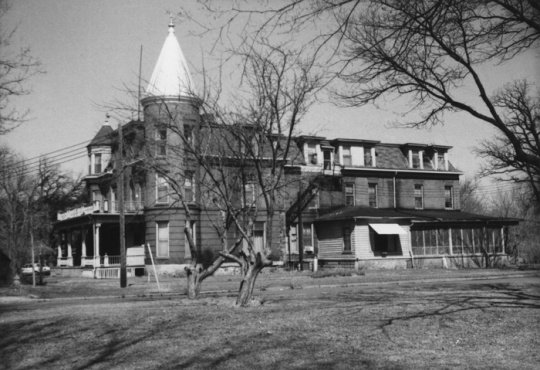
Southwest view of the Kline Sanatorium, 1978
Holding Location
Articles
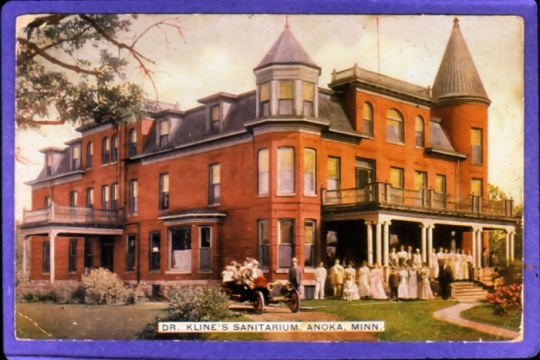
Kline Sanatorium postcard
Color postcard depicting the Kline Sanatorium, with the staff and Kline family gathered out front. Undated; photographer unknown. Anoka County Historical Society, object ID #2057.6.13. Used with the permission of the Anoka County Historical Society.
Holding Location
Articles
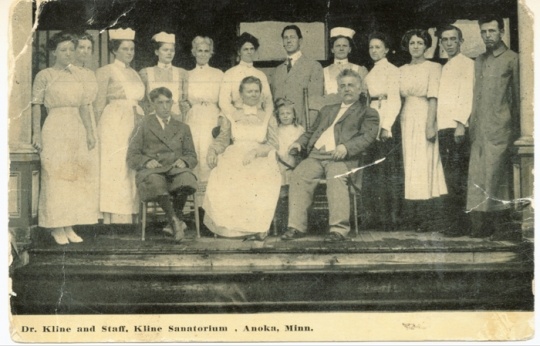
Dr. James Kline and Staff
Postcard with a photograph of Dr. James Kline and his staff on the front porch of the Kline Sanatorium. The image is undated but falls in the 1902-1932 period, while Dr. Kline worked there. Photographer unknown. Anoka County Historical Society, object ID #2057.3.8‒2.
Used with the permission of the Anoka County Historical Society.
Holding Location
Articles
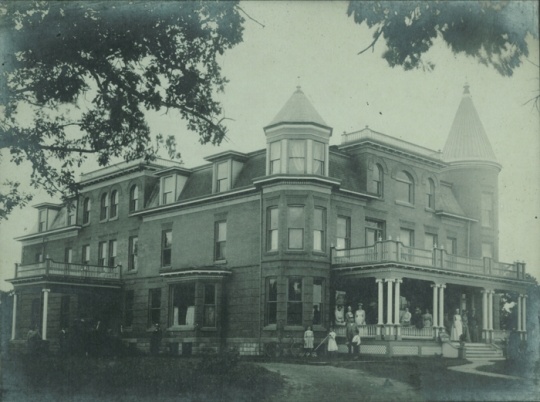
Kline Sanatorium
Holding Location
Articles
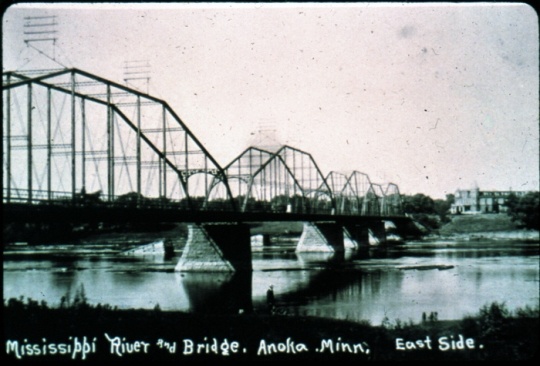
Mississippi River Bridge and Kline Sanatorium
The old Mississippi River bridge, with the Kline Sanatorium in the background at right, with a view looking north from Champlin into Anoka. Photographer unknown; captured between 1902 and 1928. Anoka County Historical Society, object ID #0003.2.59. Used with the permission of the Anoka County Historical Society.
Holding Location
Articles
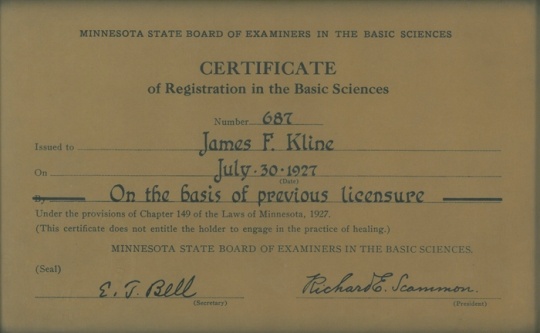
James F. Kline registration certificate
Holding Location
Articles

Southwest view of the Kline Sanatorium, 1978
Holding Location
Articles

Kline Sanatorium postcard
Color postcard depicting the Kline Sanatorium, with the staff and Kline family gathered out front. Undated; photographer unknown. Anoka County Historical Society, object ID #2057.6.13. Used with the permission of the Anoka County Historical Society.
Holding Location
Articles

Dr. James Kline and Staff
Postcard with a photograph of Dr. James Kline and his staff on the front porch of the Kline Sanatorium. The image is undated but falls in the 1902-1932 period, while Dr. Kline worked there. Photographer unknown. Anoka County Historical Society, object ID #2057.3.8‒2.
Used with the permission of the Anoka County Historical Society.
Holding Location
Articles

Kline Sanatorium
Holding Location
Articles

Mississippi River Bridge and Kline Sanatorium
The old Mississippi River bridge, with the Kline Sanatorium in the background at right, with a view looking north from Champlin into Anoka. Photographer unknown; captured between 1902 and 1928. Anoka County Historical Society, object ID #0003.2.59. Used with the permission of the Anoka County Historical Society.
Holding Location
Articles

James F. Kline registration certificate
Holding Location
Articles

Southwest view of the Kline Sanatorium, 1978
Holding Location
Articles
Related Articles
Turning Point
In 1902, workers complete a three-story, fifty-four-room medical facility for Anoka doctor James Kline.
Chronology
1893
1902
1906
1932
1935
1939
1979
Bibliography
Danson, Barb. “Dr. Kline’s Sanitarium.” Tonka Times, October 2013.
“Former Kline Hospital is Mecca for Homeless Following Tornado Disaster.” Anoka Herald, July 3, 1939.
Kiefer, Mary Ann. “Minnesota History.” Unpublished research paper. November 14, 1989.
“Kline Sanatorium.” National Register of Historic Places Nomination Form. St. Paul: State Historic Preservation Office.
https://npgallery.nps.gov/NRHP/AssetDetail?assetID=bc4cc14f-e272-4464-b292-117dd7cb0c17
“What the Sanitarium is Doing.” Anoka Herald, January 5, 1906.
Related Resources
Secondary
Minnesota Reflections. Kline Sanitarium. http://reflections.mndigital.org/cdm/ref/collection/ach/id/34
Web
ABC Newspapers. The James Kline Family.
Originally found at: http://abcnewspapers.com/2013/09/17/anoka-county-history-james-kline-family-anoka/
ABC Newspapers. The Kline Sanitarium.
http://abcnewspapers.com/2013/09/05/anoka-county-history-kline-sanitarium-anoka/
Flicker. The Kline Sanitarium. [https://www.flickr.com/photos/10609881@N07/4895459611/?ytcheck=1]
Anoka County Historical Society, Hennepin Technical College Video Production Program.
This Anoka County National Registry of Historic Places video was produced by students from Hennepin Technical College Video Production Program in Brooklyn Park, Minnesota. Produced by Anoka County Historical Society, Rebecca Ebnet-Mavencamp, Executive Director, Audra Hilse, Archivist and Sara Given, Coordinator and Directed by Dylan Salber.
https://vimeo.com/299526311







